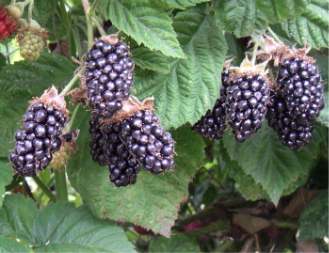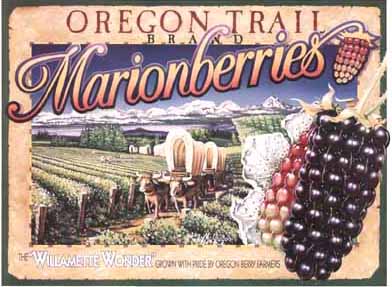Marionberries
( Rubus ursinus )
When people think of marionberries they think of this man

Marion Barry, former mayor and current Councilmember of
Washington D.C. When in reality they are these cultivars of the
blackberry.


These virtually unknown berries have delighted Oregon for over 40
years and I hope they'll delight you to.
General Marionberry Facts:
Marionberries are the most widely planted cultivar in the world
Marionberries were released in 1956 by George Waldo at the Oregon State University Agricultural Research and Development Program
Marionberries are a cross between the Chehalem and Olallie blackberry cultivars
Marionberries are named after Marion County in Oregon
Oregon is the chief producer of marionberries, producing between 28 and 33 million pounds a year, most of which is grown in the Willamette Valley the caneberry capitol of the world.
Known as a caneberry, which are berries that grow on long canes that produce fruit. Raspberries, boysenberries, loganberries and other varieties of the blackberry are included in this
Marionberries are high in antioxidants and vitamin C
Marionberries in Cooking:
Marionberries are known as exceptional berries in the culinary world. They are regarded for a large, robust taste as excellent quality for a berry. They have a distinct sweet taste but have a hint of tartness and a lasting flavor. Cooking uses include use in sweet and sour sauces as well as glazes or marinades. They are extensively used in deserts including use in pies, cakes, ice creams, sorbets and muffins. Marionberry jams, marmalades, syrups, juices are all common uses for the marionberry. Here is an example of a marionberry white wine vinegar used in a salad vinaigrette or as a marinade.
Marionberry Growing Information:
Marionberries ripe through the spring and reach their peak in late July. Usually hand picked each day lasting until late August. They are a vigorous trailing grower producing canes that can reach up to 20 feet. One acre can produce up to 12,000 pounds of fruit. The Willamette Valley climate creates a long, mild spring allows the berries to grow slowly. The climate also creates cool summer nights which allows the berries more time to hang on the cane and plump up before ripeness.
Sources:
http://www.salemhistory.net/commerce/marionberries.htm
http://www.marionberries.com/home.htm
http://www.tricountyfarm.org/oregon_raspberries.asp
Website provided by Andy Drabbs, contact me through e-mail at Andrew.Drabbs@ndsu.edu

